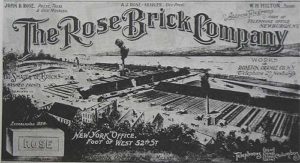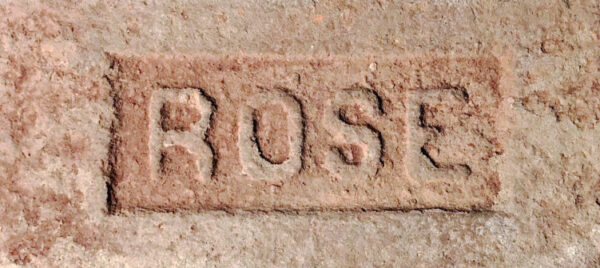 A very short distance east of Marlboro, NY, along the Hudson River at Danskammer Point, once stood the clay and sand empire of John C. Rose (of Esopus, NY), known as The Rose Brick Company.
A very short distance east of Marlboro, NY, along the Hudson River at Danskammer Point, once stood the clay and sand empire of John C. Rose (of Esopus, NY), known as The Rose Brick Company.
In 1883, Rose purchased the land because of the rich deposits of clay along the river’s banks, an abundance of nearby sand from which to make his bricks, and a nearby river to transport his product.
Rose produced high-quality bricks, all bearing the “Rose” name on their face. The business was so successful that he founded a small town near the site named Roseton. It was complete with employee housing, a school, a church, a community building, and a post office, which later received its zip code designation of 12576. The company’s philosophy toward employees was very different from those of other companies in those times:
“The Rose Brick Company was also known for its exceptional care for its workers. The surrounding community was filled with clubrooms, reading areas, stores offering lower-than-retail prices and stocked with the best food, various churches, Sunday schools, fairs, annual festivals, and excellent living accommodations. The philosophy of the Rose Brick Company was that happy, skilled workers would be the hardest workers and the best brickmakers, taking pride in creating a quality product. And they were right.”
Ad

Roseton has mostly been lost to us. When the brickyards closed, Central Hudson Gas & Electric Company bought the property and demolished the structures. The only remaining structure is the Our Lady of Mercy Chapel.
At its peak, The Rose Brick Company sold 400 million bricks annually. Most of these were shipped downriver to New York City. If you chip away at several residential or commercial structures in NYC, such as the Waldorf Astoria or Empire State Building, you will run across Rose bricks. Crushed Rose bricks were used to cover and line walkways and paths, as in Central Park.
Rose bricks were also used closer to home in their Hudson Valley birthplace. I found several in an old brick pile right on my property.
The Rose Brick Company is credited with a major industry development and efficiency: the development of a system of transporting bricks on the deck of a vessel rather than below in the hold. This allowed most vessels to carry 600,000 bricks instead of the usual 75,000.
This one is dedicated to Rose of Metro Builders Corp, who is fascinated by a brick that carries her name.
The Sojourner
Share this!
072424
